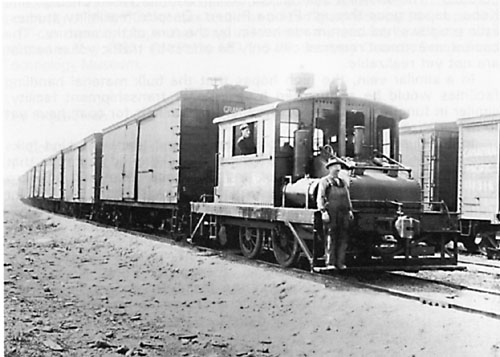McLachlin's Dinkey at Arnprior
[1][2]Arnprior, Ontario, is located on the Ottawa
River some 40 miles west of Ottawa. The arrival of the Canada Central Railway
in the town was celebrated on Thursday, December 8, 1864, with a dinner-dance
presided over by Daniel McLachlin. "The Great Railway Celebration" was the
most elaborate social event in the village since the visit of the Prince of
Wales four years earlier. A temporary terminus, including a combined passenger
station and freight shed, an engine house and turntable, was established until
the bridge over the Madawaska River was completed and access to the permanent
station site was obtained in 1865.[3]
The original railway gauge was five feet, six inches and this was changed on Easter Sunday, March 23, 1880, to standard gauge[4]. Thus Arnprior found itself on the transcontinental main line of the Canadian Pacific Railway. From that time the lumber business was booming and McLachlin Bros, had several sawmills in operation. By the turn of the century there was an extensive series of sawmill sidings and cars were moved around by "Big Car" horses. However, something more powerful was required in the form of a locomotive. A steam locomotive was out of the question because of the fire hazard. This thinking was reinforced on July 4, 1910, when fire destroyed the Gillies Bros, west lumber yard at Braeside, a little to the west. The damage in this blaze was estimated at $1,000,000[5]. Thus McLachlin Engineer Johnson produced a set of specifications for a diesel switcher which was built at the John Inglis Toronto plant about 1912. 
National Archives of Canada (PA 203600) The picture above shows the locomotive, known as the "dinkey" in what is presumably near new condition. It is lettered "M.B. No. 1." By the long string of cars it seems to be hauling it was evidently an improvement on the one horse power locomotives previously used. The other two pictures (right), taken in 1914, show the dinkey after some detailed modifications. The connecting rod driving on the leading wheel can be seen as can the steam locomotive type coupling rod. The exhaust arrangement has been changed and the earlier muffler has been replaced by four exhaust pipes suggesting that it had four cylinders. A ladder has been put up for easy access to the roof and the engine now has no lettering. There is no air brake pipe at the front so this light machine might have had fun stopping a long string of cars. The dinkey was very popular with the local kids who were for ever trying to hitch rides on it. The two engineers, Lloyd Cartwright and Jack Thorns, would spray the kids with water which they had loaded in a grease gun, a harmless method of discouraging them. This is all I have been able to find out about this interesting early diesel locomotive. It goes without saying that if anyone has any additional information, particularly when it was scrapped, I would be very pleased to hear from them.
[2] Conversations with Ray Corley, Scarborough, ON, Carl Riff, Hamilton, ON and Brian Westhouse, Rexdale, ON. [3] "Broad Gauge in the Ottawa Valley" by Wayne Tasse, 1993. ISBN 0-9697114-0-9. [4] "Van Home's Road" by Omer S.A. Lavallee, 1974. ISBN 0-919130-22-4 [5] Chesterville Record. 7 July 1910. Postscript: Around the turn of the century Arnprior was a lawless place and CPR employees had to take precautions to protect themselves. The following is taken from The Chesterville Record for June 23, 1898. Masked man at Arnprior. CPR station robbed again
but under a heavy fire.
Arnprior June 18. Last night at ten minutes to 12 the masked man visited the CPR station again. The operator, Mr. McGuire, was sitting at his table writing, when the masked man walked in and ordered him to hold up his hands. McGuire, instead coolly put his pen in his inner pocket and reached for his revolver when he was told that if he pulled it "he was a dead man", but like a flash he began to fire and did not stop until he had fired seven shots. The masked man got behind the door, and so escaped but fired on McGuire as he had to reach the window but he missed McGuire but knocked out two panes of glass. McGuire jumped out calling for help and ran to his boarding house which is quite near the station, where he soon got a number of the men to go back to the station with him, but by that time the burglar had gone taking the till with him which he had broken open. Constable Cameron of Ottawa came up by the first train, but so far no trace of him has been found, but the till, which he had thrown away on Tierney Street a short distance from the station. Bytown Railway Society, Branchline, October 2003. Letter to the Editor of Branchline: In the October 2003 edition of Branchline you published my article "McLachlin's Dinkey at Arnprior." At that time we knew very little about this interesting locomotive. I have now found a reference to it in the Renfrew Mercury of 14 May 1915: "An oil burning engine for use in hauling cars through lumber yards has been built under the direction of George H. Johnston, engineer for McLachlin Bros. The Watchman says that lumbermen everywhere will be interested in this new engine, whereby they can move lumber rapidly in their yards without danger of fire." This confirms that the small machine was home built under the supervision of Mr. George H. Johnston, the engineer for McLachlin, and it does give us a better idea of the date. It seems the machine was put into service in early 1915 and not 1914 as mentioned in the article. Unfortunately the Arnprior Watchman for this period has not survived so we may not be able to obtain further information. Colin J. Churcher, March 2005. |

